Getting Explicit Buyer Consent & Promoting Customer Transparency
Introduction
Section titled “Introduction”Corso’s Checkout Plus is designed to get explicit buyer consent so that you can add services at checkout and provide a high level of service to your customers. This starts with how services get added to the order, providing clear and transparent ways to decline any services, and easy processes to start and resolve claims for said services.
It’s important to ensure that the customer experience surrounding any additional services is both well-explained to the customer and transparent. When it comes to online user experiences, it’s critical to avoid dark patterns, even unintentional ones that might become part of the customer journey. Transparency is just good business, and additionally there are various regulations around the world that require fairness and transparency. For example, the United States Federal Trade Commission defines dark patterns as deceptive practices to “trick” users into unknowingly making purchases or giving up personal data - and there are various consumer protections in place prohibiting them.
The guidelines here help ensure that customer orders can add valuable shipping protection services in a legal, ethical, and transparent way.
Presenting the option to add shipping protection with explicit buyer consent in the cart
Section titled “Presenting the option to add shipping protection with explicit buyer consent in the cart”You can choose to give your customers the option to add additional services in the cart, prior to checkout. This approach is referred to as “Checkout Plus” throughout the Corso app.
Corso provides tools to help present information and options in a way that is trustworthy and transparent, while also giving multiple ways to opt-out through the journey. This includes:
- Clear pricing information
- Clear option to proceed to checkout with shipping protection as part of the order
- Clear option to proceed to checkout without shipping protection as part of the order.
See the image below as an example of a good implementation of these assets:
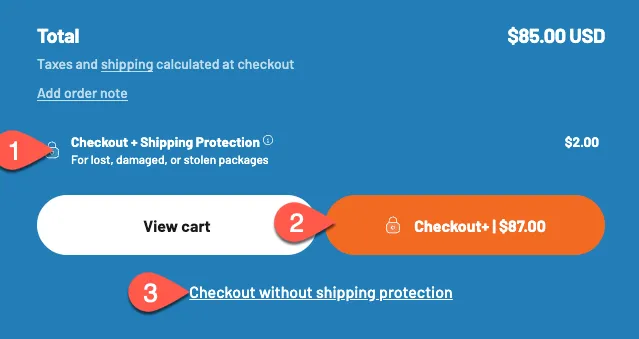
Customer payment methods
Section titled “Customer payment methods”In addition to Checkout Plus, Corso also provides tools to allow the customer to decline any additional services and charges even after getting explicit consent.
After you get explicit buyer consent from your customer, the customer can pay for additional services in 2 ways: it can be part of the order line items and subtotal. It can also be included in the shipping rate price.
In case the customer clicked on the opted-in checkout button but did not understand that it would be included at checkout, you want the customer to be able to opt-out in checkout. You should leverage Corso’s checkout extensions (Shopify Plus plans) to allow the customer to remove Shipping Protection in checkout.
Additional services as a line item
Section titled “Additional services as a line item”Here is what the extensions look like if the additional services are represented as a line item in the order:
- Checkout Plus - gets buyer consent
- Remove Extension - adds a remove button next to the product in the cart summary.
- Checkout Extension - adds a checkbox where the customer can uncheck the box when they choose their shipping options
Checkout Plus To Get Buyer Consent
Section titled “Checkout Plus To Get Buyer Consent”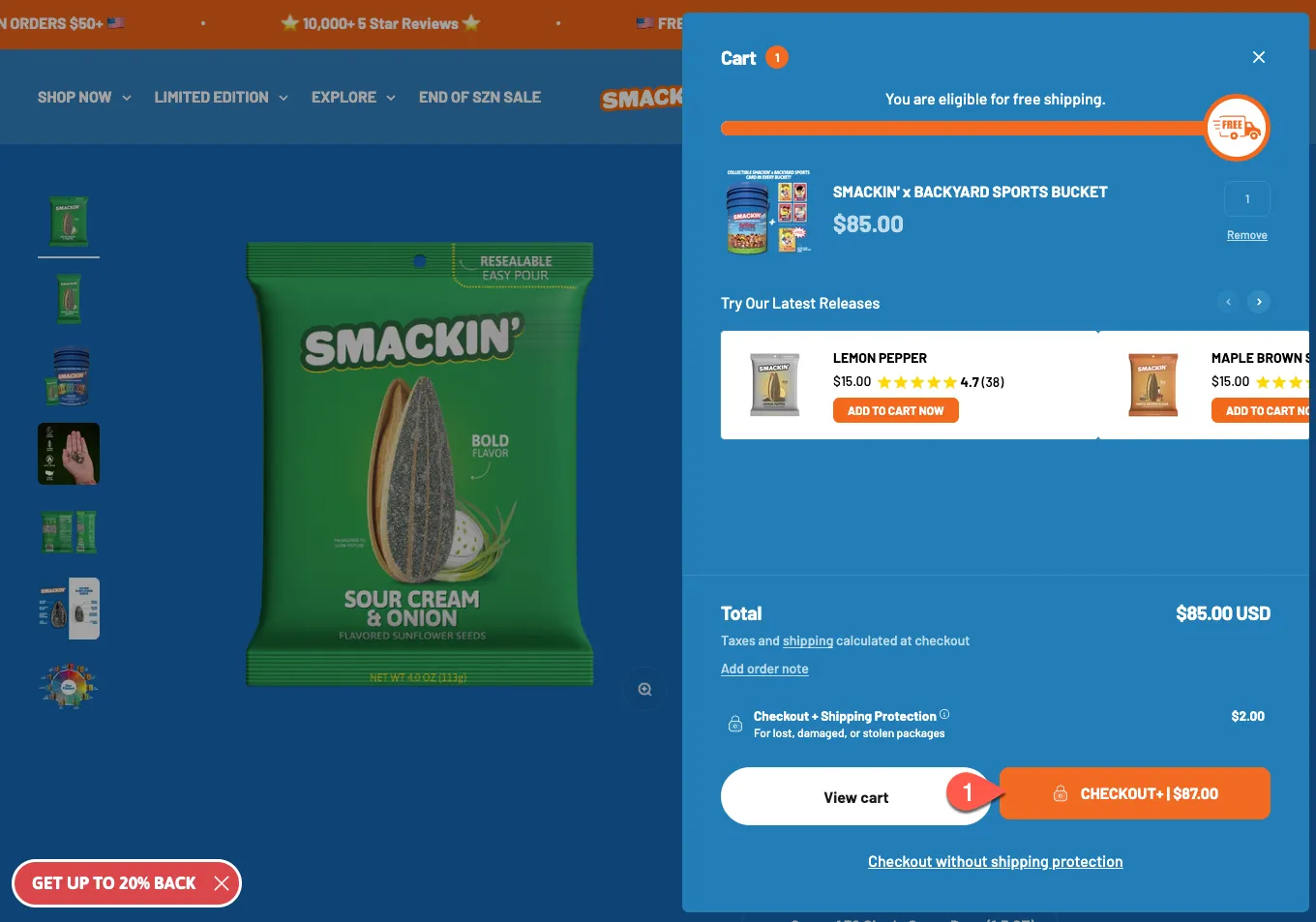
Checkout with checkout extension options to opt-out (Shopify Plus plans)
Section titled “Checkout with checkout extension options to opt-out (Shopify Plus plans)”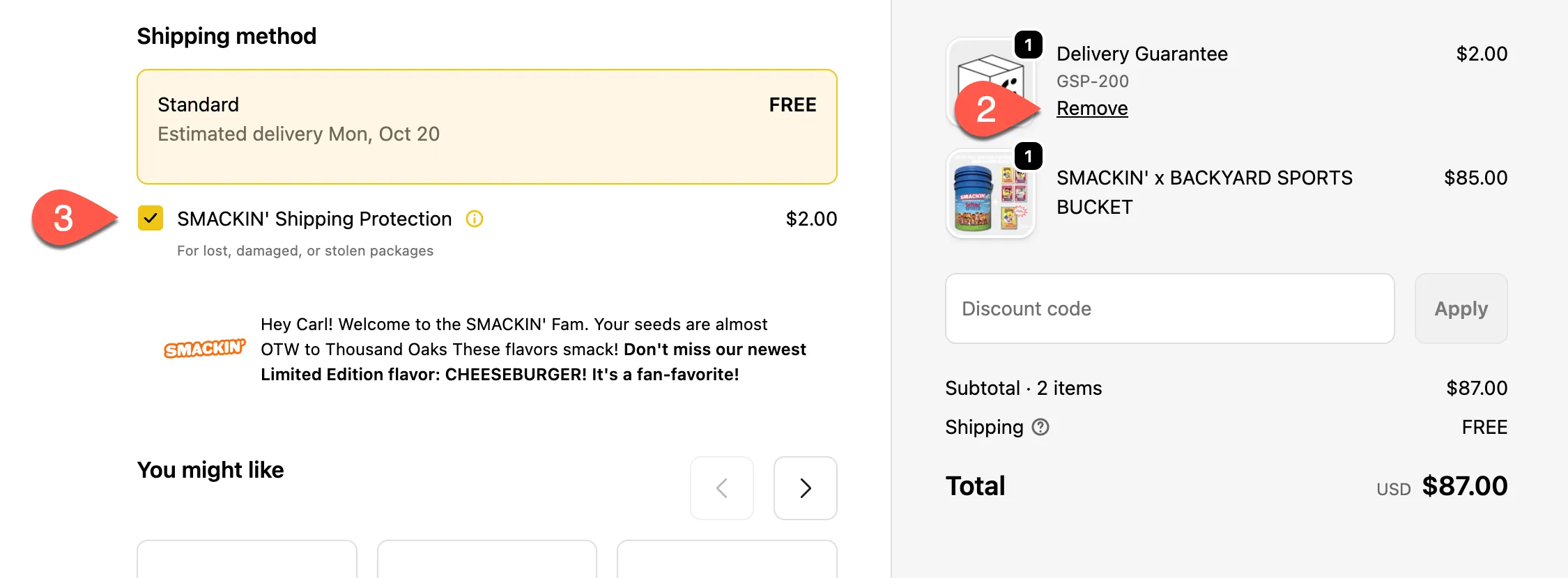
Additional services in shipping with shipping discount method
Section titled “Additional services in shipping with shipping discount method”Based on the explicit consent received in the cart, you can offer additional services as part of the rate. Here is what the extensions look like if added to the shipping rates if using a shipping discount code:
1.Checkout Plus - gets explicit buyer consent 2. Delivery Guarantee - next to the shipping rates to clearly communicate the additional cost. 3. Checkout Extension - adds an option to opt out which applies a discount code to the shipping line equivalent to the additional price.
Checkout Plus To Get Buyer Consent
Section titled “Checkout Plus To Get Buyer Consent”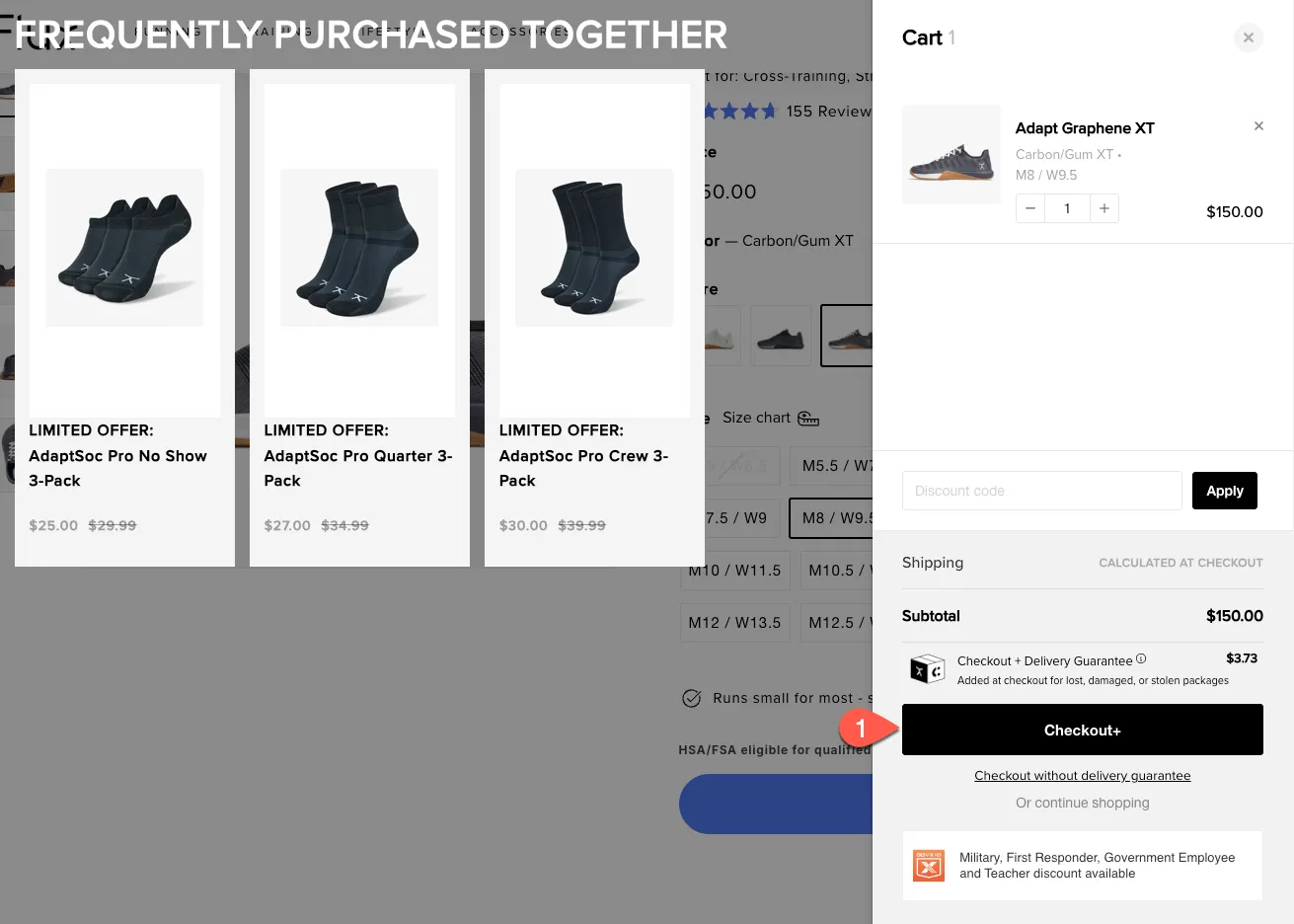
Checkout with checkout extension options to opt-out (Shopify Plus plans)
Section titled “Checkout with checkout extension options to opt-out (Shopify Plus plans)”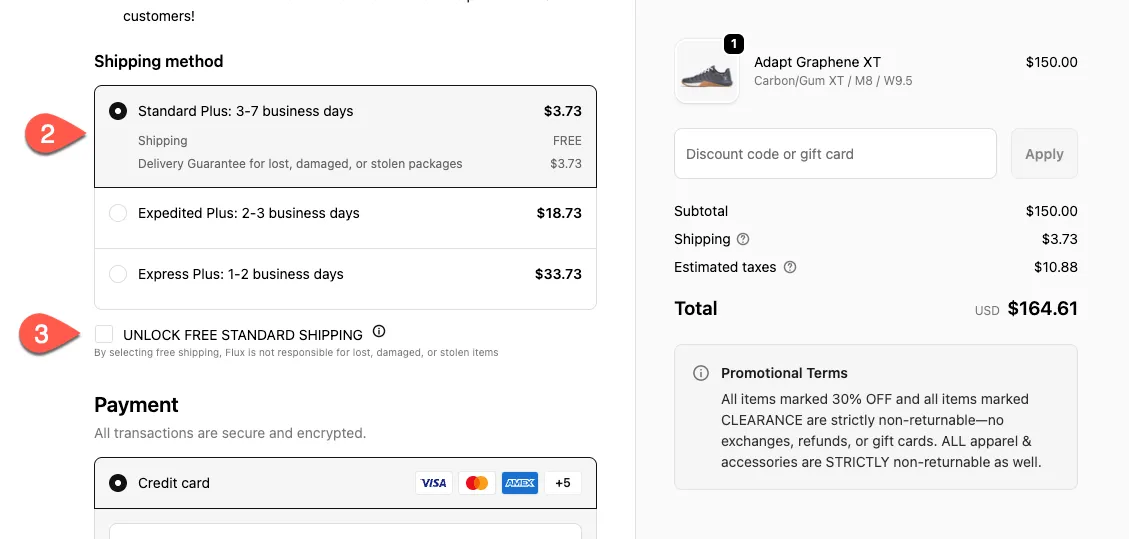
Additional services in shipping with default rate experience
Section titled “Additional services in shipping with default rate experience”Based on the explicit consent received in the cart, you can offer additional services as part of the selected rate. Here is what the extensions look like if added to the shipping rates if using standard rate display:
- Checkout Plus - gets explicit buyer consent
- Delivery Guarantee - provides a clear rate description for rates that include the additional price.
- You should give a rate option which would allow the customer to have the order shipped without the shipping protection charge.
Checkout Plus To Get Buyer Consent
Section titled “Checkout Plus To Get Buyer Consent”
Checkout with additional opted-out rate
Section titled “Checkout with additional opted-out rate”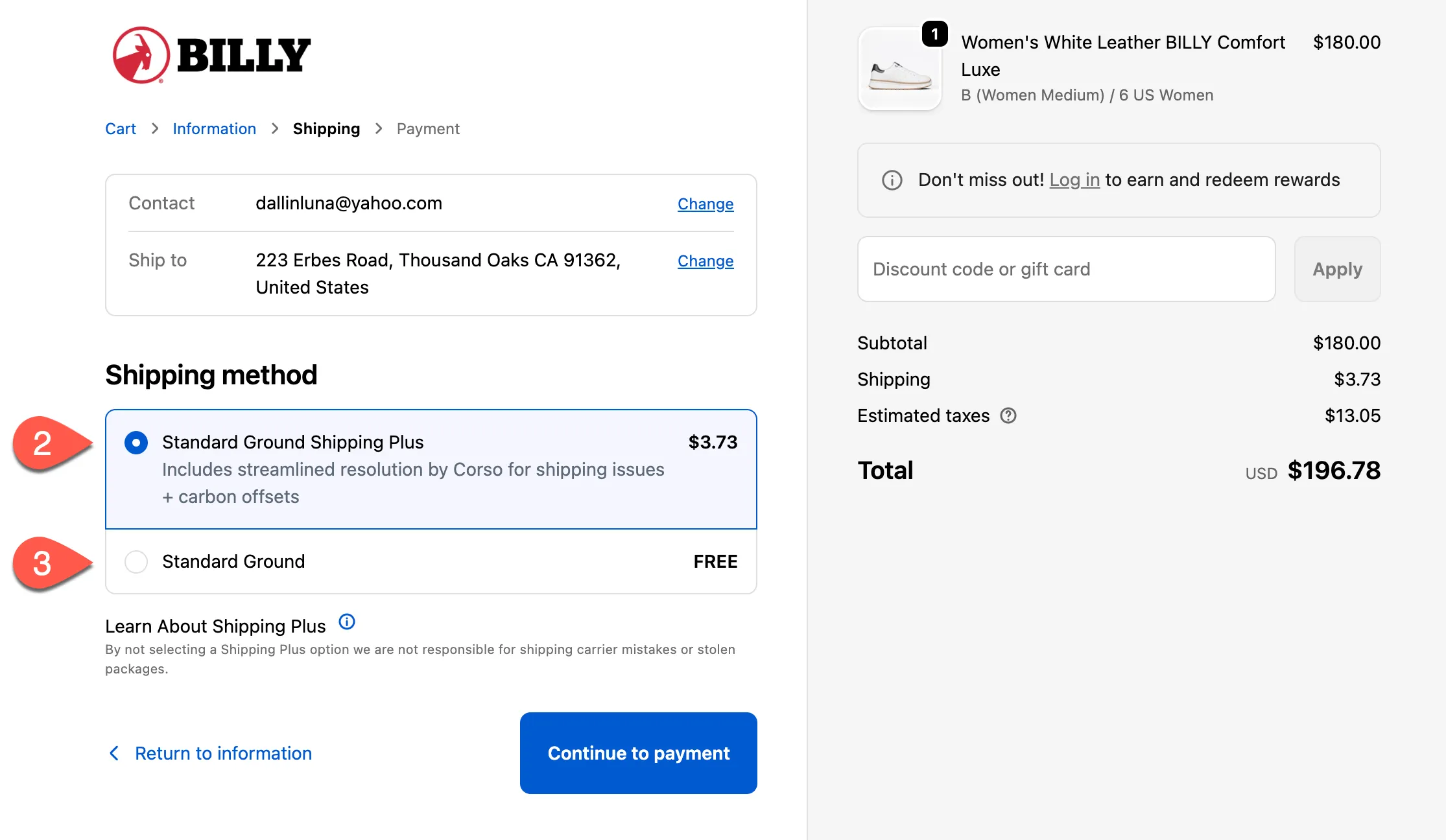
Promoting Free Shipping
Section titled “Promoting Free Shipping”If you promote free shipping to your customers, you should carefully review how the option is advertised to make sure customer expectations are met during checkout.
You may consider advertising your free shipping option as “Free Shipping Available”, for example. It is common for e-commerce merchants to have various conditions on free shipping, including:
- Destination - only certain geographies are eligible
- Shipping speed - only the slowest, least expensive shipping option is free
- Order threshold - free shipping only offered above a certain order price threshold
If your free shipping option isn’t the default during checkout, the ability to opt out of shipping protection and choose the fully free option should be readily available with the methods described above.
If you have ad copy or references to “free shipping” on your storefront, you should be careful to avoid confusion. “Free shipping on all orders over $100” implies that shipping on any order will be free. When the customer goes to check out, they may be confused when there is a shipping charge by default. When phrased as “Free shipping available on orders over $100”, customers will be aware that they need to unlock that availability and they can then decide between the shipping protection option and the free option.
Offering refunds for unwanted paid services
Section titled “Offering refunds for unwanted paid services”One of the strongest options for avoiding the perception of any dark patterns or junk fees is to offer customers the option to request a refund for any additional charges when they mistakenly checked out with that option. The Corso concierge team will work with these customers to issue that refund whenever requested, easing that burden from your own customer service team.
There are several ways to approach offering a refund for unintentional purchases. A common one is to put a snippet in the order confirmation email, with verbiage similar to the following:
“Your order is protected from shipping issues. Should you have any shipping issues with lost, damaged, missing, or stolen items, simply go here. If you don’t want streamlined resolutions for shipping issues or if this was added by mistake, please contact us.""
Links will direct the customers to Corso’s team where we can help them with any request they have.
Shipping policies
Section titled “Shipping policies”Every merchant should have a shipping policy. Shopify offers detailed documentation and even offers a template here: https://www.shopify.com/blog/shipping-policy
In addition to the standard items discussed in that blog post, your policy should include details about what is covered by shipping plus, and the policies surrounding issuing a reorder or refund. An example of a standard Corso policy could include the following (if your additional service is shipping protection):
- We offer optional shipping protection on orders in case something happens to your package during shipping. If shipping protection is not added to your order, we are not responsible for lost, damaged, stolen packages or other carrier mistakes. If your order qualifies for free shipping, you can opt out of the shipping protection service to get free shipping and waive the paid-for shipping protection service.
You should also indicate your policy for customers who have opted out. If your policy is no refunds or reorders on uncovered orders, that should be outlined here.
General best practices
Section titled “General best practices”Use clear language
Section titled “Use clear language”Customers should have all information about their purchase presented in a clear and understandable fashion. This includes mentions of shipping costs (especially any free option), instructions on how to opt in to an uncovered shipping option, and verbiage on what is covered by any additional services added to their order after getting explicit consent.
Avoid confusing customer experiences and dark patterns
Section titled “Avoid confusing customer experiences and dark patterns”A dark pattern some ecommerce merchants use is to confuse their customer by using unintuitive customer experience patterns. Hiding fees, making opt-out processes difficult to see or notice, being “tricky” with language and other parts of the customer experience, all these problematic approaches must be avoided.
Include amounts in all totals
Section titled “Include amounts in all totals”If you offer customers an option with and without additional services, the cost of that option should be made extremely obvious to the customer. When customers are weighing whether to use the shipping plus or the free shipping option for example, cost will be a factor in that decision and they should have all information, including the price, readily available to help them choose the option that works best for them.
Conclusion
Section titled “Conclusion”Following these practices will make sure you are not following any deceptive dark pattern practices in order to stay compliant with applicable guidelines. It allows you to offer valuable services to the most customers possible and maximize the use of Corso’s technology and Corso Concierge.